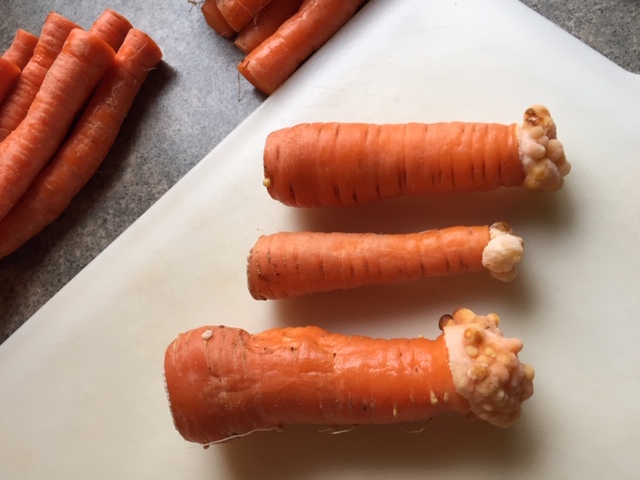
Sclerotinia
Sclerotinia spp.
Sclerotinia is a fungal disease that can affect a wide variety of vegetables, but is seen most often by home gardeners in stored carrots.
Symptoms:
- White cottony mould or mycelium on the leaves near the crown is seen following extended periods of cool wet weather in late summer/fall in actively growing plants.
- Once harvested, the infection spreads from the crowns to engulf the entire carrot root in a white fuzzy fungal mass. As the fungus matures it begins to form sclerotia (1-2cm long oval, hard, black resting bodies).
- A secondary bacterial soft rot may follow the initial sclerotinia infection of stored carrots.
Control:
- Practice a minimum three-year rotation of carrots with non-host crops in the garden (ex. Onion, beet, spinach, and corn). A good rotation would be: Year 1 = carrots, year 2 = beets, year 3 = corn, year 4 = carrots)
- Keep weeds to a minimum and provide adequate spacing between plants to ensure there is good air movement in the garden; this will help reduce relative humidity.
- Avoid over-fertilizing the carrots which encourages excessive top growth which interferes with air flow near the crown.
- Avoid watering late in the evening.
- Plant carrots on raised beds. Control soil moisture as well as flooding.
- Harvest when the carrots are cool (less than 5˚C). Sort the carrots and discard any obviously infected roots and don't store carrots that are split or broken, or otherwise damaged.
- Avoid washing carrots after harvest - cure them in a cool, dark, dry place for a few hours to help toughen the outer cells (skin) of the root, which protects them from invading bacteria or mold. After curing, gently brush off any excess soil.
- Don't trim your carrots before storing them - simply take off the tops and leave the root at the bottom intact. Any cuts (from trimming) and bruising from washing is an opportunity for the fungus and/or bacteria to take hold.
- Store carrots in the crisper with a loose wrapping of plastic or in perforated plastic bags.
- Provide good air flow and carefully maintain storage temperatures.
- Inspect the stored carrots often and immediately remove any carrots showing any sign of decay.
Sources:
Howard, R. J., Seaman, W. L., & Garland, J. A. (Eds.). (2002). Diseases and pests of vegetable crops in Canada. Vancouver, British Columbia: The Canadian Phytopathological Society and the Entomological Society of Canada.

